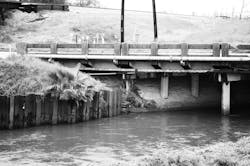During significant rainstorms, Pasadena, Texas receives excessive water flow that quickly overwhelms its pumping stations. Ample flow can cause blockage to major highways that affects hurricane evacuation routes. Because of this, the city’s main priority during major storms is to keep the routes clear and passable.
Recently, city officials and the Texas Department of Transportation turned to Grundfos and its line of Axial-Flow Submersible Pumps to solve one such flooding issue that had plagued the city for years.
Beltway 8 is one of the few main highways used to evacuate residents from the south and southwest during a hurricane. For decades, the Spencer Road exit has suffered from surface water flooding. On several occasions, the designated evacuation route was left impassable.
In cooperation with the Texas Department of Transportation, the city of Pasadena was able to determine that the cause of the flooding was insufficient capacity of the storm drain system.
In storm drain systems, flap gates are installed at or near drain outlets to prevent the drainage system from back flooding during major storms.
In the case of Beltway 8, the road’s 54-inch storm sewer lacked proper capacity, so a flap gate valve would prevent additional water from flowing back on the road. Problematically, however, that same safety valve would also limit flow into the drain, causing frequent flooding to the roadway that would result in lane closures and extended traffic delays.
Pasadena had two options. It could either create a large detention basin or it could increase the capacity of the storm system. Both options required several million dollars, as well as the allocation of real estate and years of construction.
Because of restrictions on space, project engineers reconsidered their initial two options. Instead, they decided to route excess storm water around the existing sewer and push it far enough downstream to create adequate capacity.
Grundfos’ lines of Axial-Flow Submersible Pumps are designed to meet industry standards.
The energy-efficient line can pump up to 150,000 gal per minute and features a compact design, as well as construction cost savings of up to 50%.
The Grundfos storm water pumping station offered project planners a compact, energy-efficient and cost-saving solution, which for the City of Pasadena, saved significant operation and maintenance costs when compared to similar options.
Since the city installed the pumps in 2012, the area experienced a major storm that generated six inches of rain. Amid fears of flooding, the new pumping station efficiently moved more than 30,000 gallons of flood water per minute for roughly five hours—keeping the highway clear and safe.
Source: Grundfos North America

